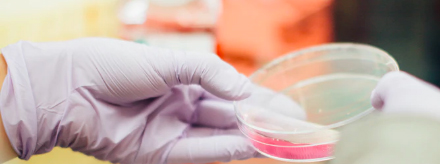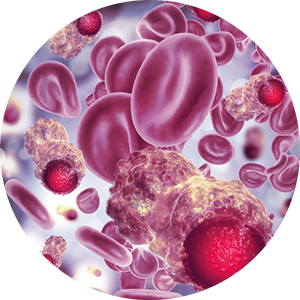About trublood
trublood was developed by Datar Cancer Genetics based on the results of several clinical studies and validated on more than 40,000 samples. These included samples from asymptomatic subjects undergoing screening tests such as mammograms, colonoscopies, PAP smears, serum CA markers and other clinical examinations, as well as more than 17,000 samples from patients with various cancers and patients with benign diseases.
trublood basics
- Tumours release thousands of cells into the circulation, where circulating tumour cells (CTCs) survive for about 1 - 2.5 hours.
- In order to detach from the primary tumour and disseminate into the blood, cells must undergo a cellular process known as Epithelial Mesenchymal Transition (EMT).
- EMT enhances migratory capabilities of tumour cells, which allows cells to penetrate into the vasculature and circulate as single or clusters of circulating tumour cells.
- CTCs extravasate having undergone the reverse process known as Mesenchymal to Epithelial Transition (MET) and are able to colonise at distant organs.
- CTCs are defined as EpCAM (+), PanCK (+), CD45 (-) cells. Circulating tumour associated cells (C-TACs) are EpCAM (+), PanCK (+), CD45 (+/-) cells of tumourigenic origin in peripheral blood.
- Non-tumourigenic cells in peripheral blood have functional apoptotic mechanism, but CTCs and C-TACs are resistant to apoptosis.
- An epigenetically active stabilising process can eliminate normal cells and confer survival privilege on apoptosis-resistant CTCs and C-TACs.
- Sufficient C-TACs can be enriched and harvested for immunocytochemistry (ICC) profiling with markers used in immunohisto-chemistry (IHC) which aid in determination of histopathological subtypes of tumour tissue.
- Antibody clones used in the trublood assay for analysis of tumour antigens / markers are internationally approved for IVD use.
trublood is particulary recommended for ...

... symptomatic individuals who have been advised an invasive tissue biopsy to check for mailgnancy.

... patients where an invasive biopsy has been inconclusive or inconsistent with clinical observations.

... suspected metastatic relapse to rule out new primary.
trublood can complement, or if necessary, replace invasive biopsies.
trublood in comparison
-
Usual Tissue Biopsy / FNAC
Usual Tissue Biopsy / FNACtrublood®
trublood®
-
Usual Tissue Biopsy / FNAC
Invasive, need of tissuetrublood®
Minimally invasive
-
Usual Tissue Biopsy / FNAC
Usually painful, possible stitches and scarstrublood®
No pain, no stitches, no scars; only one blood draw
-
Usual Tissue Biopsy / FNAC
Risk of tumour cell seedingtrublood®
No risk
-
Usual Tissue Biopsy / FNAC
Risky procedure for organs like lung, liver, pancreastrublood®
No risk of injury to any organ / bleeding
-
Usual Tissue Biopsy / FNAC
Possibly misleading as it is site / time dependenttrublood®
Provides real time data and covers all active sites
-
Usual Tissue Biopsy / FNAC
Serial / sequential biopsies are impossibletrublood®
Can be performed as often as necessary
-
Usual Tissue Biopsy / FNAC
Not viable if primary tumor is not easily visualisedtrublood®
Viable even if primary / metastasis are undetectable
Sample collection

Basic diagnostics (total 3 tubes containing 26 ml whole blood)
Blood draw: 3 EDTA tubes (purple colour cap) - 2 x 10 ml and 1 x 6 ml - in total: 26 ml
Basic diagnostics + cfDNA (trublood Comprehensive)
(total 4 tubes containing 36 ml whole blood)
- First draw : 10 ml DCG tube (brown colour cap)
- Second draw: 3 x EDTA tubes (purple colour cap) - 2 x 10 ml and 1 x 6 ml - in total: 26 ml
Note:
Sequence of draw should not be altered. Blood should be drawn only and only as per above method. Blood draw should be performed only by qualified phlebotomist under medical supervision. Ship at +2°C to +6°C in the container provided by DCG.
Precautions:
- The patient must not have received any form of cancer therapy (radiation / chemo-therapy / surgery / endocrine therapy etc.) at least 15 days prior to collection of sample.
- The patient must not have received oral or IV corticosteroids at least 15 days prior to collection of sample.
- Patient has no current febrile or any other acute inflammatory illness.
- Patient does not have acute exacerbation or flare-up of an inflammatory condition requiring escalation in medical therapy at least 5 days prior to collection of sample.
- Patient has not received blood transfusion / PET-CT / CT scan at least 5 days prior to collection of sample.
- Patient is not positive for HIV / HBV / HCV.
FAQ
trublood is suitable for every individual who desires a risk free biopsy.
Circulating tumour cells (CTCs) and Nucleic Acid are isolated from patient’s blood sample and extensively analysed for diagnosis, prognosis and theranostics.
The analytes, which are examined, are CTCs, cell-free DNA + RNA as well as Germline DNA.
- 26 ml - 36 ml peripheral blood as per protocol depending upon extent of test
- 5 - 6 hours fasting before test
- Turn-Around-Time: 10 days from receipt of the sample


